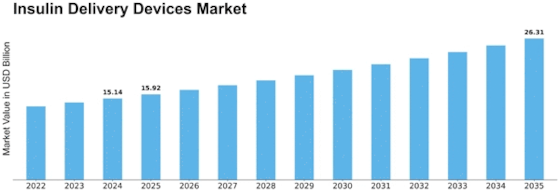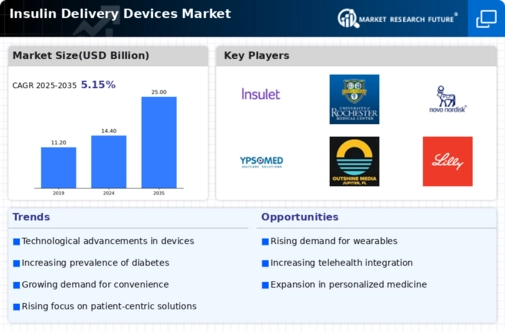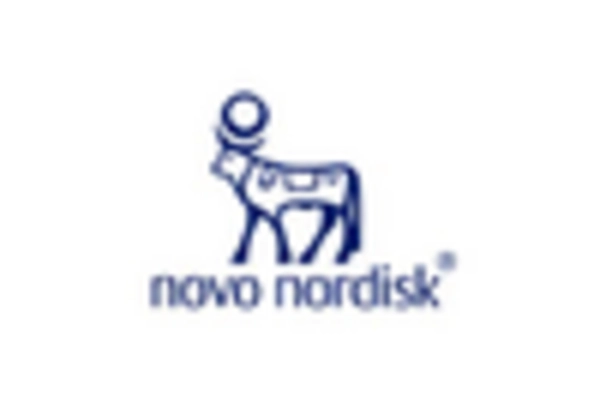Insulin Syringes
Insulin Pens
Insulin Pumps
Smart Insulin Devices
Hospitals
Home Care Settings
Diabetes Clinics
Analogue Insulin Delivery Devices
Pen-Needle Systems
Continuous Glucose Monitoring System
Subcutaneous Injection
Intravenous Injection
Inhaled Insulin
North America
Europe
South America
Asia Pacific
Middle East and Africa
North America Outlook (USD Billion, 2019-2035)
North America Insulin Delivery Devices Market by Device Type
Insulin Syringes
Insulin Pens
Insulin Pumps
Smart Insulin Devices
North America Insulin Delivery Devices Market by End User Type
Hospitals
Home Care Settings
Diabetes Clinics
North America Insulin Delivery Devices Market by Product Type
Analogue Insulin Delivery Devices
Pen-Needle Systems
Continuous Glucose Monitoring Systems
North America Insulin Delivery Devices Market by Mode of Delivery Type
Subcutaneous Injection
Intravenous Injection
Inhaled Insulin
North America Insulin Delivery Devices Market by Regional Type
US
Canada
US Outlook (USD Billion, 2019-2035)
US Insulin Delivery Devices Market by Device Type
Insulin Syringes
Insulin Pens
Insulin Pumps
Smart Insulin Devices
US Insulin Delivery Devices Market by End User Type
Hospitals
Home Care Settings
Diabetes Clinics
US Insulin Delivery Devices Market by Product Type
Analogue Insulin Delivery Devices
Pen-Needle Systems
Continuous Glucose Monitoring Systems
US Insulin Delivery Devices Market by Mode of Delivery Type
Subcutaneous Injection
Intravenous Injection
Inhaled Insulin
CANADA Outlook (USD Billion, 2019-2035)
CANADA Insulin Delivery Devices Market by Device Type
Insulin Syringes
Insulin Pens
Insulin Pumps
Smart Insulin Devices
CANADA Insulin Delivery Devices Market by End User Type
Hospitals
Home Care Settings
Diabetes Clinics
CANADA Insulin Delivery Devices Market by Product Type
Analogue Insulin Delivery Devices
Pen-Needle Systems
Continuous Glucose Monitoring Systems
CANADA Insulin Delivery Devices Market by Mode of Delivery Type
Subcutaneous Injection
Intravenous Injection
Inhaled Insulin
Europe Outlook (USD Billion, 2019-2035)
Europe Insulin Delivery Devices Market by Device Type
Insulin Syringes
Insulin Pens
Insulin Pumps
Smart Insulin Devices
Europe Insulin Delivery Devices Market by End User Type
Hospitals
Home Care Settings
Diabetes Clinics
Europe Insulin Delivery Devices Market by Product Type
Analogue Insulin Delivery Devices
Pen-Needle Systems
Continuous Glucose Monitoring Systems
Europe Insulin Delivery Devices Market by Mode of Delivery Type
Subcutaneous Injection
Intravenous Injection
Inhaled Insulin
Europe Insulin Delivery Devices Market by Regional Type
Germany
UK
France
Russia
Italy
Spain
Rest of Europe
GERMANY Outlook (USD Billion, 2019-2035)
GERMANY Insulin Delivery Devices Market by Device Type
Insulin Syringes
Insulin Pens
Insulin Pumps
Smart Insulin Devices
GERMANY Insulin Delivery Devices Market by End User Type
Hospitals
Home Care Settings
Diabetes Clinics
GERMANY Insulin Delivery Devices Market by Product Type
Analogue Insulin Delivery Devices
Pen-Needle Systems
Continuous Glucose Monitoring Systems
GERMANY Insulin Delivery Devices Market by Mode of Delivery Type
Subcutaneous Injection
Intravenous Injection
Inhaled Insulin
UK Outlook (USD Billion, 2019-2035)
UK Insulin Delivery Devices Market by Device Type
Insulin Syringes
Insulin Pens
Insulin Pumps
Smart Insulin Devices
UK Insulin Delivery Devices Market by End User Type
Hospitals
Home Care Settings
Diabetes Clinics
UK Insulin Delivery Devices Market by Product Type
Analogue Insulin Delivery Devices
Pen-Needle Systems
Continuous Glucose Monitoring Systems
UK Insulin Delivery Devices Market by Mode of Delivery Type
Subcutaneous Injection
Intravenous Injection
Inhaled Insulin
FRANCE Outlook (USD Billion, 2019-2035)
FRANCE Insulin Delivery Devices Market by Device Type
Insulin Syringes
Insulin Pens
Insulin Pumps
Smart Insulin Devices
FRANCE Insulin Delivery Devices Market by End User Type
Hospitals
Home Care Settings
Diabetes Clinics
FRANCE Insulin Delivery Devices Market by Product Type
Analogue Insulin Delivery Devices
Pen-Needle Systems
Continuous Glucose Monitoring Systems
FRANCE Insulin Delivery Devices Market by Mode of Delivery Type
Subcutaneous Injection
Intravenous Injection
Inhaled Insulin
RUSSIA Outlook (USD Billion, 2019-2035)
RUSSIA Insulin Delivery Devices Market by Device Type
Insulin Syringes
Insulin Pens
Insulin Pumps
Smart Insulin Devices
RUSSIA Insulin Delivery Devices Market by End User Type
Hospitals
Home Care Settings
Diabetes Clinics
RUSSIA Insulin Delivery Devices Market by Product Type
Analogue Insulin Delivery Devices
Pen-Needle Systems
Continuous Glucose Monitoring Systems
RUSSIA Insulin Delivery Devices Market by Mode of Delivery Type
Subcutaneous Injection
Intravenous Injection
Inhaled Insulin
ITALY Outlook (USD Billion, 2019-2035)
ITALY Insulin Delivery Devices Market by Device Type
Insulin Syringes
Insulin Pens
Insulin Pumps
Smart Insulin Devices
ITALY Insulin Delivery Devices Market by End User Type
Hospitals
Home Care Settings
Diabetes Clinics
ITALY Insulin Delivery Devices Market by Product Type
Analogue Insulin Delivery Devices
Pen-Needle Systems
Continuous Glucose Monitoring Systems
ITALY Insulin Delivery Devices Market by Mode of Delivery Type
Subcutaneous Injection
Intravenous Injection
Inhaled Insulin
SPAIN Outlook (USD Billion, 2019-2035)
SPAIN Insulin Delivery Devices Market by Device Type
Insulin Syringes
Insulin Pens
Insulin Pumps
Smart Insulin Devices
SPAIN Insulin Delivery Devices Market by End User Type
Hospitals
Home Care Settings
Diabetes Clinics
SPAIN Insulin Delivery Devices Market by Product Type
Analogue Insulin Delivery Devices
Pen-Needle Systems
Continuous Glucose Monitoring Systems
SPAIN Insulin Delivery Devices Market by Mode of Delivery Type
Subcutaneous Injection
Intravenous Injection
Inhaled Insulin
REST OF EUROPE Outlook (USD Billion, 2019-2035)
REST OF EUROPE Insulin Delivery Devices Market by Device Type
Insulin Syringes
Insulin Pens
Insulin Pumps
Smart Insulin Devices
REST OF EUROPE Insulin Delivery Devices Market by End User Type
Hospitals
Home Care Settings
Diabetes Clinics
REST OF EUROPE Insulin Delivery Devices Market by Product Type
Analogue Insulin Delivery Devices
Pen-Needle Systems
Continuous Glucose Monitoring Systems
REST OF EUROPE Insulin Delivery Devices Market by Mode of Delivery Type
Subcutaneous Injection
Intravenous Injection
Inhaled Insulin
APAC Outlook (USD Billion, 2019-2035)
APAC Insulin Delivery Devices Market by Device Type
Insulin Syringes
Insulin Pens
Insulin Pumps
Smart Insulin Devices
APAC Insulin Delivery Devices Market by End User Type
Hospitals
Home Care Settings
Diabetes Clinics
APAC Insulin Delivery Devices Market by Product Type
Analogue Insulin Delivery Devices
Pen-Needle Systems
Continuous Glucose Monitoring Systems
APAC Insulin Delivery Devices Market by Mode of Delivery Type
Subcutaneous Injection
Intravenous Injection
Inhaled Insulin
APAC Insulin Delivery Devices Market by Regional Type
China
India
Japan
South Korea
Malaysia
Thailand
Indonesia
Rest of APAC
CHINA Outlook (USD Billion, 2019-2035)
CHINA Insulin Delivery Devices Market by Device Type
Insulin Syringes
Insulin Pens
Insulin Pumps
Smart Insulin Devices
CHINA Insulin Delivery Devices Market by End User Type
Hospitals
Home Care Settings
Diabetes Clinics
CHINA Insulin Delivery Devices Market by Product Type
Analogue Insulin Delivery Devices
Pen-Needle Systems
Continuous Glucose Monitoring Systems
CHINA Insulin Delivery Devices Market by Mode of Delivery Type
Subcutaneous Injection
Intravenous Injection
Inhaled Insulin
INDIA Outlook (USD Billion, 2019-2035)
INDIA Insulin Delivery Devices Market by Device Type
Insulin Syringes
Insulin Pens
Insulin Pumps
Smart Insulin Devices
INDIA Insulin Delivery Devices Market by End User Type
Hospitals
Home Care Settings
Diabetes Clinics
INDIA Insulin Delivery Devices Market by Product Type
Analogue Insulin Delivery Devices
Pen-Needle Systems
Continuous Glucose Monitoring Systems
INDIA Insulin Delivery Devices Market by Mode of Delivery Type
Subcutaneous Injection
Intravenous Injection
Inhaled Insulin
JAPAN Outlook (USD Billion, 2019-2035)
JAPAN Insulin Delivery Devices Market by Device Type
Insulin Syringes
Insulin Pens
Insulin Pumps
Smart Insulin Devices
JAPAN Insulin Delivery Devices Market by End User Type
Hospitals
Home Care Settings
Diabetes Clinics
JAPAN Insulin Delivery Devices Market by Product Type
Analogue Insulin Delivery Devices
Pen-Needle Systems
Continuous Glucose Monitoring Systems
JAPAN Insulin Delivery Devices Market by Mode of Delivery Type
Subcutaneous Injection
Intravenous Injection
Inhaled Insulin
SOUTH KOREA Outlook (USD Billion, 2019-2035)
SOUTH KOREA Insulin Delivery Devices Market by Device Type
Insulin Syringes
Insulin Pens
Insulin Pumps
Smart Insulin Devices
SOUTH KOREA Insulin Delivery Devices Market by End User Type
Hospitals
Home Care Settings
Diabetes Clinics
SOUTH KOREA Insulin Delivery Devices Market by Product Type
Analogue Insulin Delivery Devices
Pen-Needle Systems
Continuous Glucose Monitoring Systems
SOUTH KOREA Insulin Delivery Devices Market by Mode of Delivery Type
Subcutaneous Injection
Intravenous Injection
Inhaled Insulin
MALAYSIA Outlook (USD Billion, 2019-2035)
MALAYSIA Insulin Delivery Devices Market by Device Type
Insulin Syringes
Insulin Pens
Insulin Pumps
Smart Insulin Devices
MALAYSIA Insulin Delivery Devices Market by End User Type
Hospitals
Home Care Settings
Diabetes Clinics
MALAYSIA Insulin Delivery Devices Market by Product Type
Analogue Insulin Delivery Devices
Pen-Needle Systems
Continuous Glucose Monitoring Systems
MALAYSIA Insulin Delivery Devices Market by Mode of Delivery Type
Subcutaneous Injection
Intravenous Injection
Inhaled Insulin
THAILAND Outlook (USD Billion, 2019-2035)
THAILAND Insulin Delivery Devices Market by Device Type
Insulin Syringes
Insulin Pens
Insulin Pumps
Smart Insulin Devices
THAILAND Insulin Delivery Devices Market by End User Type
Hospitals
Home Care Settings
Diabetes Clinics
THAILAND Insulin Delivery Devices Market by Product Type
Analogue Insulin Delivery Devices
Pen-Needle Systems
Continuous Glucose Monitoring Systems
THAILAND Insulin Delivery Devices Market by Mode of Delivery Type
Subcutaneous Injection
Intravenous Injection
Inhaled Insulin
INDONESIA Outlook (USD Billion, 2019-2035)
INDONESIA Insulin Delivery Devices Market by Device Type
Insulin Syringes
Insulin Pens
Insulin Pumps
Smart Insulin Devices
INDONESIA Insulin Delivery Devices Market by End User Type
Hospitals
Home Care Settings
Diabetes Clinics
INDONESIA Insulin Delivery Devices Market by Product Type
Analogue Insulin Delivery Devices
Pen-Needle Systems
Continuous Glucose Monitoring Systems
INDONESIA Insulin Delivery Devices Market by Mode of Delivery Type
Subcutaneous Injection
Intravenous Injection
Inhaled Insulin
REST OF APAC Outlook (USD Billion, 2019-2035)
REST OF APAC Insulin Delivery Devices Market by Device Type
Insulin Syringes
Insulin Pens
Insulin Pumps
Smart Insulin Devices
REST OF APAC Insulin Delivery Devices Market by End User Type
Hospitals
Home Care Settings
Diabetes Clinics
REST OF APAC Insulin Delivery Devices Market by Product Type
Analogue Insulin Delivery Devices
Pen-Needle Systems
Continuous Glucose Monitoring Systems
REST OF APAC Insulin Delivery Devices Market by Mode of Delivery Type
Subcutaneous Injection
Intravenous Injection
Inhaled Insulin
South America Outlook (USD Billion, 2019-2035)
South America Insulin Delivery Devices Market by Device Type
Insulin Syringes
Insulin Pens
Insulin Pumps
Smart Insulin Devices
South America Insulin Delivery Devices Market by End User Type
Hospitals
Home Care Settings
Diabetes Clinics
South America Insulin Delivery Devices Market by Product Type
Analogue Insulin Delivery Devices
Pen-Needle Systems
Continuous Glucose Monitoring Systems
South America Insulin Delivery Devices Market by Mode of Delivery Type
Subcutaneous Injection
Intravenous Injection
Inhaled Insulin
South America Insulin Delivery Devices Market by Regional Type
Brazil
Mexico
Argentina
Rest of South America
BRAZIL Outlook (USD Billion, 2019-2035)
BRAZIL Insulin Delivery Devices Market by Device Type
Insulin Syringes
Insulin Pens
Insulin Pumps
Smart Insulin Devices
BRAZIL Insulin Delivery Devices Market by End User Type
Hospitals
Home Care Settings
Diabetes Clinics
BRAZIL Insulin Delivery Devices Market by Product Type
Analogue Insulin Delivery Devices
Pen-Needle Systems
Continuous Glucose Monitoring Systems
BRAZIL Insulin Delivery Devices Market by Mode of Delivery Type
Subcutaneous Injection
Intravenous Injection
Inhaled Insulin
MEXICO Outlook (USD Billion, 2019-2035)
MEXICO Insulin Delivery Devices Market by Device Type
Insulin Syringes
Insulin Pens
Insulin Pumps
Smart Insulin Devices
MEXICO Insulin Delivery Devices Market by End User Type
Hospitals
Home Care Settings
Diabetes Clinics
MEXICO Insulin Delivery Devices Market by Product Type
Analogue Insulin Delivery Devices
Pen-Needle Systems
Continuous Glucose Monitoring Systems
MEXICO Insulin Delivery Devices Market by Mode of Delivery Type
Subcutaneous Injection
Intravenous Injection
Inhaled Insulin
ARGENTINA Outlook (USD Billion, 2019-2035)
ARGENTINA Insulin Delivery Devices Market by Device Type
Insulin Syringes
Insulin Pens
Insulin Pumps
Smart Insulin Devices
ARGENTINA Insulin Delivery Devices Market by End User Type
Hospitals
Home Care Settings
Diabetes Clinics
ARGENTINA Insulin Delivery Devices Market by Product Type
Analogue Insulin Delivery Devices
Pen-Needle Systems
Continuous Glucose Monitoring Systems
ARGENTINA Insulin Delivery Devices Market by Mode of Delivery Type
Subcutaneous Injection
Intravenous Injection
Inhaled Insulin
REST OF SOUTH AMERICA Outlook (USD Billion, 2019-2035)
REST OF SOUTH AMERICA Insulin Delivery Devices Market by Device Type
Insulin Syringes
Insulin Pens
Insulin Pumps
Smart Insulin Devices
REST OF SOUTH AMERICA Insulin Delivery Devices Market by End User Type
Hospitals
Home Care Settings
Diabetes Clinics
REST OF SOUTH AMERICA Insulin Delivery Devices Market by Product Type
Analogue Insulin Delivery Devices
Pen-Needle Systems
Continuous Glucose Monitoring Systems
REST OF SOUTH AMERICA Insulin Delivery Devices Market by Mode of Delivery Type
Subcutaneous Injection
Intravenous Injection
Inhaled Insulin
MEA Outlook (USD Billion, 2019-2035)
MEA Insulin Delivery Devices Market by Device Type
Insulin Syringes
Insulin Pens
Insulin Pumps
Smart Insulin Devices
MEA Insulin Delivery Devices Market by End User Type
Hospitals
Home Care Settings
Diabetes Clinics
MEA Insulin Delivery Devices Market by Product Type
Analogue Insulin Delivery Devices
Pen-Needle Systems
Continuous Glucose Monitoring Systems
MEA Insulin Delivery Devices Market by Mode of Delivery Type
Subcutaneous Injection
Intravenous Injection
Inhaled Insulin
MEA Insulin Delivery Devices Market by Regional Type
GCC Countries
South Africa
Rest of MEA
GCC COUNTRIES Outlook (USD Billion, 2019-2035)
GCC COUNTRIES Insulin Delivery Devices Market by Device Type
Insulin Syringes
Insulin Pens
Insulin Pumps
Smart Insulin Devices
GCC COUNTRIES Insulin Delivery Devices Market by End User Type
Hospitals
Home Care Settings
Diabetes Clinics
GCC COUNTRIES Insulin Delivery Devices Market by Product Type
Analogue Insulin Delivery Devices
Pen-Needle Systems
Continuous Glucose Monitoring Systems
GCC COUNTRIES Insulin Delivery Devices Market by Mode of Delivery Type
Subcutaneous Injection
Intravenous Injection
Inhaled Insulin
SOUTH AFRICA Outlook (USD Billion, 2019-2035)
SOUTH AFRICA Insulin Delivery Devices Market by Device Type
Insulin Syringes
Insulin Pens
Insulin Pumps
Smart Insulin Devices
SOUTH AFRICA Insulin Delivery Devices Market by End User Type
Hospitals
Home Care Settings
Diabetes Clinics
SOUTH AFRICA Insulin Delivery Devices Market by Product Type
Analogue Insulin Delivery Devices
Pen-Needle Systems
Continuous Glucose Monitoring Systems
SOUTH AFRICA Insulin Delivery Devices Market by Mode of Delivery Type
Subcutaneous Injection
Intravenous Injection
Inhaled Insulin
REST OF MEA Outlook (USD Billion, 2019-2035)
REST OF MEA Insulin Delivery Devices Market by Device Type
Insulin Syringes
Insulin Pens
Insulin Pumps
Smart Insulin Devices
REST OF MEA Insulin Delivery Devices Market by End User Type
Hospitals
Home Care Settings
Diabetes Clinics
REST OF MEA Insulin Delivery Devices Market by Product Type
Analogue Insulin Delivery Devices
Pen-Needle Systems
Continuous Glucose Monitoring Systems
REST OF MEA Insulin Delivery Devices Market by Mode of Delivery Type
Subcutaneous Injection
Intravenous Injection
Inhaled Insulin


















Leave a Comment